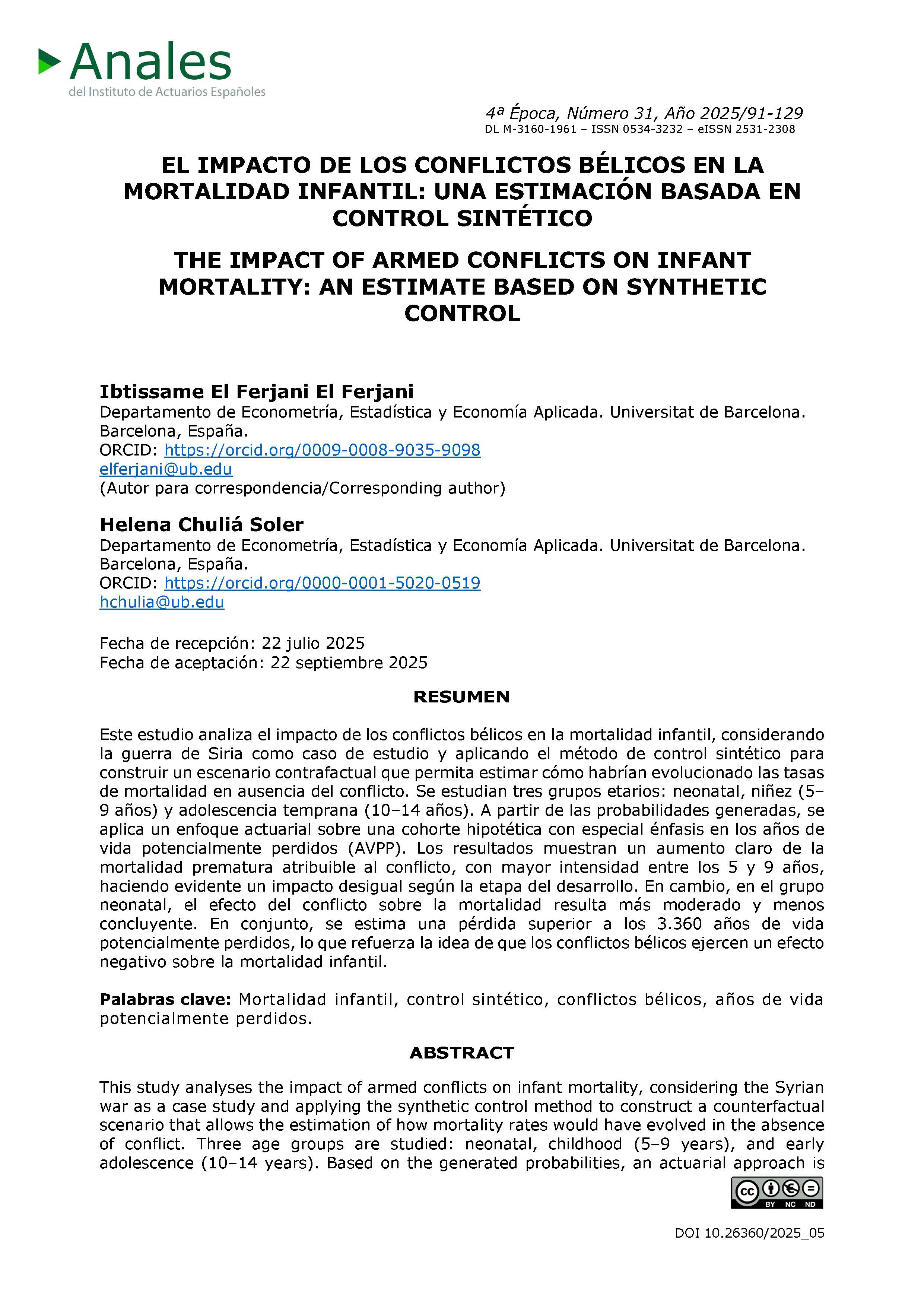The impact of armed conflicts on infant mortality: an estimate based on synthetic control
DOI:
https://doi.org/10.26360/2025_05Keywords:
infant mortality, synthetic control, armed conflicts, years of potential life lostAbstract
This study analyses the impact of armed conflicts on infant mortality, considering the Syrian war as a case study and applying the synthetic control method to construct a counterfactual scenario that allows the estimation of how mortality rates would have evolved in the absence of conflict. Three age groups are studied: neonatal, childhood (5–9 years), and early adolescence (10–14 years). Based on the generated probabilities, an actuarial approach is applied to a hypothetical cohort, with particular emphasis on years of potential life lost (YPLL). The results show a clear increase in premature mortality due to the conflict, with greater intensity among those aged 5 to 9, highlighting an unequal impact according to the stage of development. In contrast, within the neonatal group, the effect of the conflict on mortality appears more moderate and less conclusive. Overall, a loss of more than 3.360 years of potential life lost is estimated, underlining the idea that armed conflicts have a negative effect on infant mortality
Downloads
References
Abadie, A. (2021). Using Synthetic Controls: Feasibility, Data Requirements, and Methodological Aspects. Journal of Economic Literature, 59(2), 391-425. https://doi.org/10.1257/jel.20191450
Abadie, A., Diamond, A., & Hainmueller, J. (2010). Synthetic control methods for comparative case studies: Estimating the effect of California’s Tobacco Control Program. Journal of the American Statistical Association, 105(490), 493–505. https://doi.org/10.1198/jasa.2009.ap08746
Abadie, A., Diamond, A., & Hainmueller, J. (2011). Synth: An R package for synthetic control methods in comparative case studies. Journal of Statistical Software, 42, 1–17. https://doi.org/10.18637/jss.v042.i13
Abadie, A., & Gardeazabal, J. (2003). The economic costs of conflict: A case study of the Basque Country. American Economic Review, 93(1), 112–132. https://doi.org/10.1257/000282803321455188
Arriaga, E. E. (1996). Los años de vida perdidos: su utilización para medir el nivel y cambio de la mortalidad. Notas de Población, 24(63), 7–38. https://hdl.handle.net/11362/12508
Athey, S., & Imbens, G. W. (2017). The state of applied econometrics: Causality and policy evaluation. Journal of Economic Perspectives, 31(2), 3–32. https://doi.org/10.1257/jep.31.2.3
Ayuso, M., Corrales, H., Guillén, M., Pérez-Marín, A. M., & Rojo, J. L. (2007). Estadística actuarial vida. Publicacions i Edicions de la Universitat de Barcelona
Badari, V. S., Gopal, Y. S., & Devaramani, S. C. (1991). Infant mortality, its components and correlates: findings from a longitudinal study in rural Karnataka, India. Genus, 89–108.
Bonander, C. (2017). Compared with what? Estimating the effects of injury prevention policies using the synthetic control method. Injury Prevention, 24(1), 45–50. https://doi.org/10.1136/injuryprev-2017-042360
Buggs, S., Webster, D., & Crifasi, C. (2021). Using synthetic control methodology to estimate effects of a Cure Violence intervention in Baltimore, Maryland. Injury Prevention. Advance online publication. https://doi.org/10.1136/injuryprev-2020-044056
Butz, W. P., Habicht, J. P., & DaVanzo, J. (1984). Environmental factors in the relationship between breastfeeding and infant mortality: The role of sanitation and water in Malaysia. American Journal of Epidemiology, 119(4), 516–525. https://doi.org/10.1093/oxfordjournals.aje.a113769
DeJong, J., Ghattas, H., Bashour, H., Mourtada, R., Akik, C., & Reese-Masterson, A. (2017). Reproductive, maternal, neonatal and child health in conflict: A case study on Syria using Countdown indicators. BMJ Global Health.. https://doi.org/10.1136/bmjgh-2017-000302
Dube, L., Taha, M., & Asefa, H. (2013). Determinants of infant mortality in community of Gilgel Gibe Field Research Center, Southwest Ethiopia: A matched case control study. BMC Public Health, 13, 401. https://doi.org/10.1186/1471-2458-13-401
Guha-Sapir, D., & Panhuis, W. V. (2004). Conflict-related mortality: An analysis of 37 datasets. Disasters, 28(4), 418–428. https://doi.org/10.1111/j.0361-3666.2004.00267.x
Jawad, M., Hone, T., Vamos, E., Roderick, P., Sullivan, R., & Millett, C. (2020). Estimating indirect mortality impacts of armed conflict in civilian populations: Panel regression analyses of 193 countries, 1990–2017. BMC Medicine, 18, 348. https://doi.org/10.1186/s12916-020-01708-5
Jawad, M., Hone, T., Vamos, E., Cetorelli, V., & Millett, C. (2021). Implications of armed conflict for maternal and child health: A regression analysis of data from 181 countries for 2000–2019. PLOS Medicine, 18(9), e1003810. https://doi.org/10.1371/journal.pmed.1003810
Morelos, J. (1996) “[State of Mexico, Analysis of Some Determinants of Infant and Child Mortality in the Urban Environment, 1990].” Estudios Sociológicos.
Joshi, M. (2015). Comprehensive peace agreement implementation and reduction in neonatal, infant and under-5 mortality rates in post-armed conflict states, 1989–2012. BMC International Health and Human Rights, 15, 27. https://doi.org/10.1186/s12914-015-0066-7
Khadka, K. B., Lieberman, L. S., Giedraitis, V., Bhatta, L., & Pandey, G. (2015). The socio-economic determinants of infant mortality in Nepal: Analysis of Nepal Demographic Health Survey, 2011. BMC Pediatrics, 15, 152. https://doi.org/10.1186/s12887-015-0468-7
Kešeljević, A., & Spruk, R. (2024). Estimating the effects of Syrian civil war. Empirical Economics, 66(2), 671–703. https://doi.org/10.1007/s00181-023-02470-2
Kiross, G. T., Chojenta, C., Barker, D., & Loxton, D. (2021). Individual-, household- and community-level determinants of infant mortality in Ethiopia. PLOS ONE, 16(3), e0248501. https://doi.org/10.1371/journal.pone.0248501
Kreif, N., Grieve, R., Hangartner, D., Turner, A., Nikolova, S., & Sutton, M. (2015). Examination of the synthetic control method for evaluating health policies with multiple treated units. Health Economics, 25(12), 1514–1528. https://doi.org/10.1002/hec.3258
Lichtenheld, A. G., & Schon, J. (2021). The consequences of internal displacement on civil war violence: Evidence from Syria. Political Geography, 86, 102346. https://doi.org/10.1016/j.polgeo.2021.102346
Lindskog, E. E. (2016). The effect of war on infant mortality in the Democratic Republic of Congo. BMC Public Health, 16, 1059. https://doi.org/10.1186/s12889-016-3685-6
Maia, L. T. S., Souza, W. V., & Mendes, A. D. (2020). Individual and contextual determinants of infant mortality in Brazilian state capitals: A multilevel approach. Cadernos de Saúde Pública, 36(3), e00057519. https://doi.org/10.1590/0102-311X00057519
Masset, E. (2022). Conflict and child mortality in Mali: A synthetic control analysis. Population and Development Review, 48(4), 1035–1062. https://doi.org/10.1111/padr.12523
Minoiu, C., & Shemyakina, O. N. (2014). Armed conflict, household victimization, and child health in Côte d'Ivoire. Journal of Development Economics, 108, 237–255. https://doi.org/10.1016/j.jdeveco.2014.03.003
Olper, A., Curzi, D., & Swinnen, J. (2018). Trade liberalization and child mortality: A synthetic control method. World Development, 110, 394–410. https://doi.org/10.1016/j.worlddev.2018.05.034
Orischak, M., Fru, D. N., Kelly, E., & DeFranco, E. A. (2022). Social determinants of infant mortality amongst births to non-Hispanic Black women. American Journal of Obstetrics and Gynecology, 226(1S), S706. https://doi.org/10.1016/j.ajog.2021.11.1164
Ostby, G., & Rustad, S. A. (2024). 473 million Children Live in Conflict Zones. PRIO Blogs. https://blogs.prio.org/2024/10/473-million-children-live-in-conflict-zones/
Save the Children. (2021). 10 años de guerra en Siria: el 86% de los niños y niñas refugiados sirios no quiere regresar a su país. https://www.savethechildren.es/notasprensa/10-anos-de-guerra-en-siria-el-86-de-los-ninos-y-ninas-refugiados-sirios-no-quiere
Souza, A. C. T. D., Cufino, E., Peterson, K. E., Gardner, J., Amaral, M. I. V. D., & Ascherio, A. (1999). Variations in infant mortality rates among municipalities in the State of Ceará, Northeast Brazil: An ecological analysis. International Journal of Epidemiology, 28(2), 267–273. https://doi.org/10.1093/ije/28.2.267
Thom, M. (2022). Can additional funding improve mental health outcomes? Evidence from a synthetic control analysis of California’s Millionaire Tax. PLOS ONE, 17(7), e0271063. https://doi.org/10.1371/journal.pone.0271063
Tian, W., Lee, S., & Panchenko, V. (2023). Synthetic controls with multiple outcomes: Estimating the effects of non-pharmaceutical interventions in the COVID-19 pandemic. UNSW Economics Working Paper No. 2023-05. https://doi.org/10.2139/ssrn.4409610
UNESCO. (2011). Una crisis encubierta: conflictos armados y educación. Informe de Seguimiento de la Educación para Todos en el Mundo. https://www.unesco.org/gem-report/es/hidden-crisis-armed-conflict-and-education
UNICEF España. (2024a). La infancia sufre cada vez más los efectos de los conflictos armados. https://www.unicef.es/noticia/la-infancia-sufre-cada-vez-mas-los-efectos-de-los-conflictos-armados
UNICEF España. (2024b). Semana del Desarme: las consecuencias de los conflictos armados en los niños. https://www.unicef.es/noticia/semana-del-desarme-las-consecuencias-de-los-conflictos-armados-en-los-ninos
UNICEF. (2025a). La inmunización y los conflictos. https://www.unicef.org/es/inmunizacion/inmunizacion-y-conflictos
UNICEF (2025b). Crisis de Siria: 8,4 millones de niños necesitan ayuda humanitaria. https://www.unicef.es/noticia/crisis-de-siria-84-millones-de-ninos-necesitan-ayuda-humanitaria
Weiss, W., Piya, B., Andrus, A., Ahsan, K., & Cohen, R. (2022). Estimating the impact of donor programs on child mortality in low- and middle-income countries: A synthetic control analysis of child health programs funded by the United States Agency for International Development. Population Health Metrics, 19, 3. https://doi.org/10.1186/s12963-021-00278-9

Downloads
Published
How to Cite
Issue
Section
License
Copyright (c) 2025 Ibtissame El Ferjani El Ferjani, Helena Chuliá Soler

This work is licensed under a Creative Commons Attribution-NonCommercial-NoDerivatives 4.0 International License.

















